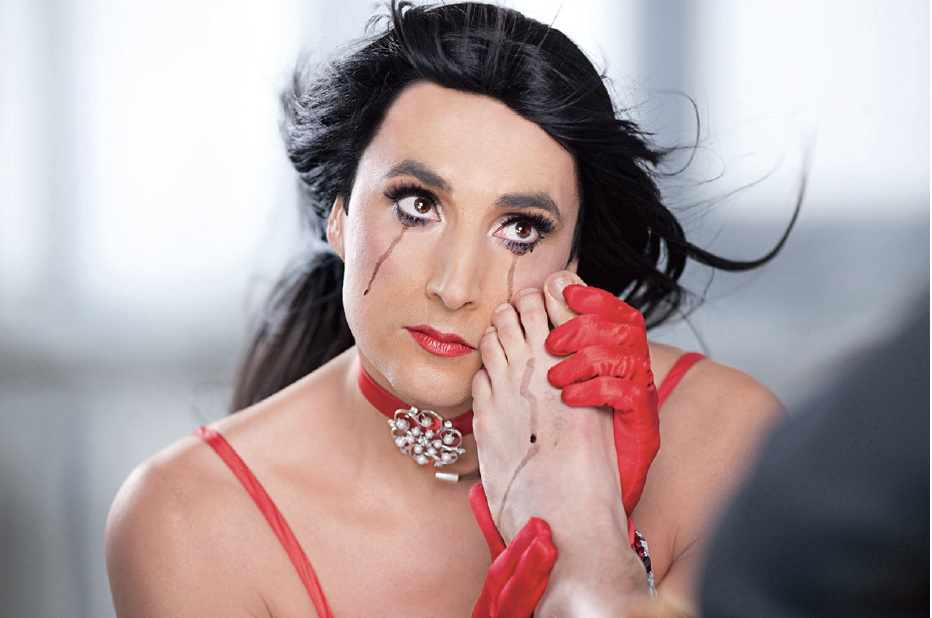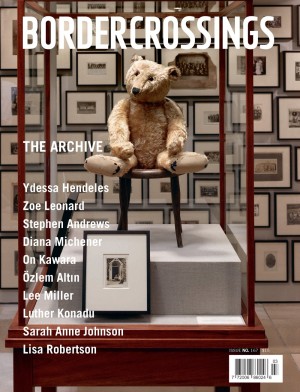Kent Monkman
The trouble with origins is that they can be so foundational. And retellings, by their very citation, often only make the original stronger. What’s great about this very rich exhibition, Kent Monkman’s “My Treaty is With The Crown” at the Leonard & Bina Ellen Art Gallery, Concordia University, is the playful, often ambiguous way it revisits history by placing strong contemporary images in dialogue with traditional and historical objects.
Monkman, the Toronto-based artist of Cree ancestry, presents three monumental new paintings as well as a new video, several etchings and the fabulous Cree Leggings (Worn in the presence of the Prince of Wales), 2011, alongside historical objects that contextualize defining scenes in Canadian history, including the battle on the Plains of Abraham. It’s a motherlode of information wherein political agitation is the mother of invention. Much of the exhibition’s witty appeal and political bite comes in the form of a Mother—a gorgeous, badass Queen, Monkman’s doppelganger Miss Chief Eagle Testickle—who gives a queer wink to the historic triangulation of French, English and First Nations culture. Her presence insists on the perspectival aspect of history, on the artifice of identity and twists the felt “fixed-ness” of intercultural power dynamics via a curious mix of sincerity and camp.
Monkman transforms the gallery into an encampment with two minimalist tents and a soundscape of crickets, horse murmurs and night calls that beckon another time. Two dark blue tents, marked alternately with fleur-de-lis and Union Jacks, dominate the space. Inside, placed at the centre is a pillowcase, one monogrammed with a W for Wolfe, the general who led the British at the Battle on the Plains of Abraham, the other with an M for the Marquis de Montcalm, who led the French forces. Both died in the battle. The pillowcases remind us of this, each marked with a ghostly impression: a face, rendered in smudged make-up, the mouths shaping “o.” Or is it, “Oh”? Here, sex and death conjoin to convey an erotics of violence and power.

Kent Monkman, My Treaty Is With The Crown, 2011, installation view. Photograph: Paul Smith. Courtesy Leonard & Bina Ellen Art Gallery.
Two paintings hang beyond the tents. In Montcalm’s Haircut, 2011, Miss Chief sits bedside by a sleeping Montcalm. She looks over her shoulder at the viewer, clipping Montcalm’s hair as a sword and rifle rest near by. In Wolfe’s Haircut, 2011, Miss Chief is naked, in pink heels, watching the tent opening with scissors poised to cut her own hair. A glass of wine and a candle sit on the table by the bed. Styled in the Romantic tradition of 19th-century European landscape painting, the images place a queer subject—naked, native, vulnerable, empowered—at the centre of the historic scene. By rendering scenes of intimacy, Monkman marks the entwined pragmatics of life in the early colony and shows the extent of English and French betrayals of Indian peoples. More, he inserts a high level of possibility into an encounter that might have turned out differently.
Objects and paintings borrowed from the McCord Museum of Canadian History, the Montreal Museum of Fine Arts and Monkman’s own collection help contextualize the scenes’ significance. Heroic depictions of Montcalm’s and Wolfe’s death, for instance, memorialized in etchings and on porcelain, surround the tents. Affixed to the gallery’s back wall are several cases holding traditional First Nations objects: Choker, Plains, 1920; Smoking Cap, Iroquois, 1900; and Wall Pocket, Iroquois, 1889, among others. These objects do multiple jobs, fleshing out historical perspective and pointing to the cultural theft that characterized imperialism. At the same time, he situates historical objects within a continuum of contemporary indigenous practice. “We’re here,” they seem to whisper. “We were always here.”
Elsewhere in the gallery, Monkman imagines the story of Mary Magdalene, the whore turned saint, stitched onto an envisioned encounter between Miss Chief and the Prince of Wales, who did come to Montreal in 1860. In the painting entitled Saint Mary Magdalene in the Desert, 1784, by Jean-Joseph Taillasson, Mary appears in prayer, kneeling by a rock, the surrounding forest about to overwhelm her. Her hands are clasped, her feet bare, as a scroll of text unfurls nearby and jewels tumble from a fallen red chest. In Monkman’s elegant replay, My Treaty is With The Crown, 2011, a shirtless Miss Chief sits at the feet of the Prince of Wales, her penis erect, her eyes streaked with mascara tears. British forces, a horse and several dogs surround and threaten to overtake her. To the left, several Indians stand firmly watching the scene. Nearby, a Louis Vuitton bag splays open.

Kent Monkman, Mary, 2011, film still, high definition video. Courtesy Bailey Fine Arts, Toronto.
Here, First Nations know-how—so key in the development of the fur trade and the economic success of the colony—is sidelined by imperialist violence. Here, too, Miss Chief exposes the love and hate of the encounter. The hard dick and exposed body recall colonialist notions of the primitive—oversexed, pure musculature—and at the same time envision sex across the colour line and stage desire as a two-way street.
There is much more to see in this fine exhibition, but I’ll stop with Mary/Marie, 2011, a short film in which Miss Chief enters a fantasy room—white sheer fabrics, glass beads, all blowing in the wind—dressed in red sequins. She struts up to a seated Prince of Wales, kneels and kisses his feet. A series of texts read: “We had an agreement,” and “I agreed to share not to surrender,” and “How could you break your promise?” The Prince, whose eyes we never see, clenches his fist, opens his mouth, all aquiver. Finally, as Wagner’s Liebestod (Tristan und Isolde) soars, black drops fall on the Prince’s feet. Cut to Miss Chief’s face, tilted as per Mary Magdalene but with mascara running. I burst out laughing, then paused as the screen blackened and scrolling text noted how First Nations and the Crown had different interpretations of the treaties, and yet they remain building blocks to future resolutions. Fun yes; ambiguous, sure. But this collection of images never let me turn away from the shady goings-on and political betrayal that continue to shape our encounter with the First Nations. ❚
My Treaty is With The Crown was exhibited at Leonard & Bina Ellen Art Gallery at Concordia University in Montreal from March 4 to April 16, 2011.
M J Thompson is a writer living in Brooklyn and Montreal.

